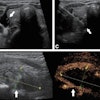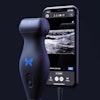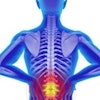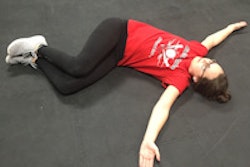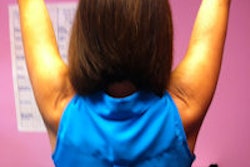
Advances in imaging technology will lead medical facilities to use ultrasound more in place of costly, invasive procedures, which means that more procedures will be conducted outside hospitals and more sonographers will be needed.
The U.S. Bureau of Labor Statistics predicts that sonographer employment will increase by 46% between 2012 and 2022, a growth rate that is among the highest on U.S. News and World Report's list of best jobs of 2015. While hospitals are the biggest employers of diagnostic medical sonographers, rapid employment growth will take place in physicians' offices and medical and diagnostic laboratories, according to the magazine.
 Sonographer Doug Wuebben and his daughter.
Sonographer Doug Wuebben and his daughter.
At the same time, evidence continues to accumulate on the risk of musculoskeletal injuries for sonographers. In a study published in 2009, researchers at Yale University found that despite the use of ergonomically designed ultrasound equipment, 96% of their female sonographers experienced some type of musculoskeletal symptom within a 12-month time frame.
The study, conducted through the school's Occupational and Environmental Medicine Program, found that shoulder (73%) and lower back (69%) symptoms were the most common ailments, followed by wrist and hand issues (54%).
If you analyze the two references above, the information is startling. The healthcare industry as a whole is one of the fastest-growing career sector industries in the U.S., and realistically that likely coincides with the rest of the world.
To highlight this dynamic further:
- Ultrasound growth is exploding. More patients worldwide will be seeing the benefits of advanced healthcare using ultrasound. Sonographers will have job security at the price of being much busier, which means more patients, studies, and workload.
- Ergonomic equipment is great and necessary, but studies show that better equipment design provides minimal benefit for eliminating the pain and injuries that nearly every sonographer endures.
Increased demand
While the need for more sonographers is a great thing, the increase in the number of sonographer positions worldwide will not keep pace with the increased workload. The bean counters will get involved, and in my simple opinion, the result will be more workload for sonographers.
In my conversations with sonographers all over the world, the talk inevitably turns to "doing more with less." One extra exam during your workday will slowly creep into two. You get my point.
I've been in healthcare a long time, and I know that profit margins are very tight. A healthcare institution is, after all, a business, and the goal of any business is to make a profit. It has also been my experience that the bean counters normally get their way. Until something changes, that's the way most institutions will operate. I have my own ideas on that change, but those are perhaps best saved for another article.
The job of a sonographer is physically demanding and takes a toll on the body. Increased workload will only aggravate pain and injury symptoms. Preventing injuries is the best medicine for a sonographer to keep doing his or her job at a high level.
Taking control
If you have been following our series on AuntMinnie.com, or you've had the opportunity to sit in on one of our presentations, then you know you have options. You can be in charge of your body and eliminate the pain that plagues the majority of sonographers.
I was nearly debilitated by bilateral shoulder pain early on in my career. My colleague, Mark Roozen, a strength and conditioning performance specialist with National Football League experience, completely cured my near career-ending injury. His philosophy of training body "movement" and not muscles is amazing.
Training movement simply means that you look at the body as a whole unit, albeit with different parts and zones. All of our zones tie in with each other and need to be considered as part of how the injury process occurred -- and, more importantly, how it can be cured. Our education is tied to "corrective" exercise as opposed to "fitness" exercise.
I go to work every day no longer wondering if I am going to be able to make it through the day. I love what I do, and I'm good at what I do. I make a difference because I have passion and love for this field, and I am doing my job pain-free, which enables me to do my best for every patient.
Everything in our lives is the result of a choice we have made. If you want a different result, make a different choice. I feel empowered and excited about life. The trials and struggles that I went through when I thought I was going to have to leave my job also were a blessing in disguise.
As educator and motivational speaker Stephen Covey said, "I'm not a product of my circumstances. I am a product of my decisions." I took control of my situation, got out of my comfort zone, and took back my body and my life.
Since that tortured time in my life, I've learned a very important lesson. I realized that my circumstances no longer hold me back. I have the power to make positive decisions to propel me forward. My present circumstances merely determine where I start. Great stuff!
'Stretch of the weak'
Our website contains a "Stretch of the weak," every week. I've included a recent example below. There are many great tips, stretches, and exercises available on the website.
Psoas lunge stretch
Many people will do lunges, pushing the hips forward to stretch what they feel is the hip flexors and the psoas. The iliacus crossing the hip is stretched in the traditional lunge, but the psoas crosses the hip and all lumbar joints.
It can only be stretched when isolated with a lunge that includes spine lateral bending with some twist and extension motion. This can be a great stretch before, during, or after work. Stretch and hold for 20 to 30 seconds and repeat several times, going both directions.
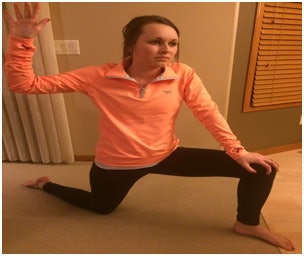 Psoas lunge stretch. Image courtesy of Doug Wuebben.
Psoas lunge stretch. Image courtesy of Doug Wuebben.You can also learn more by attending our presentation on Sunday, March 22, from 3:30 p.m. to 5:30 p.m., at the American Institute of Ultrasound in Medicine (AIUM) annual meeting in Lake Buena Vista, FL.
Doug Wuebben is a registered echocardiographer and also a consultant, national presenter, and author of e-books in the areas of ergonomics, exercise and pain, and injury correction for sonographers. He has also been published on the topics of telemedicine and achieving lab accreditation. Mark Roozen is a strength and performance coach and also the owner and president of Performance Edge Training Systems (PETS). Wuebben and Roozen are co-founders of Live Pain Free -- The Right Moves. Email [email protected] or go to coachrozy.com for more information on programs or speaking requests or if you have any questions or comments.
The comments and observations expressed herein are those of the authors and do not necessarily reflect the opinions of AuntMinnie.com.
